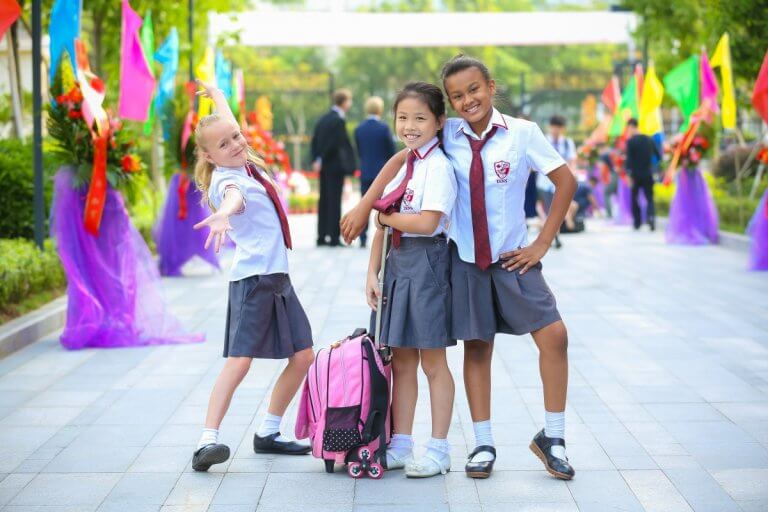
In today’s rapidly evolving society, schools are ramping up their efforts to prepare students for a digitally-focused world.
With the use of virtual reality labs, interactive whiteboards and other technologies, student classrooms in international schools look very different than they did a mere ten years ago.
The use of technology is beneficial in classrooms because children and young adults are already familiar with computers and social media, already so deeply entwined in our daily lives.
When used for learning, students become more alert and engaged because they are comfortable with technology and most don’t find it confusing or complicated to use, making them highly adaptable to adopting new technologies.
Schools must be innovative in order to keep children interested and engaged, and international schools must keep this up since it’s such a highly competitive field.

Source: Bangkok Patana School
Many educators today are also seeing the effects and benefits of explorative learning – a method used to create new ideas and knowledge by exposing children to the natural environment and allowing them to engage in hands-on learning.
While this used to come in the form of a ‘field trip’, schools today are going further, incorporating more outdoor learning activities, community service events, trips abroad, and other ways of bringing children out to explore the world around them.
Children learn better when learning is fun – that’s when the line between work and play is blurred, and they don’t even realise they’re actually ‘studying’ when they’re doing so through hands-on activities that are engaging, relatable and interesting.
Activities like these teach them how to grasp ideas that could be too complicated to understand straight from a textbook or classroom lecture.

Source: International School of Nanshan Shenzhen
Here are two schools which have successfully adopted innovative ways of using technology and explorative learning…
BANGKOK PATANA SCHOOL
As Thailand’s first and largest British international school for students aged 2 to 18, this not-for-profit school is dedicated to offering a holistic and well-rounded education.
The Outdoor Classroom is one unique project that shows the school’s commitment to being innovative and creative when it comes to hands-on learning.
Rather than utilise only textbooks or search engines for research, Bangkok Patana’s Secondary Biology students explore flora and fauna to find creatures they’d like to study.
The fresh air and hands-on learning methods deepen students’ understanding to a level unlikely to be facilitated in the classroom, allowing students to produce powerful research before creating biological illustrations of their respective creatures.

Source: Bangkok Patana School
In Design and Technology, senior students work with a local community centre for children with physical disabilities. Each student designs and produces a piece of equipment that will make daily life easier for these children. The prototype pieces are taken to the community centre, used by the children and then adjusted for any shortcomings.
Students then attend a trade show for equipment related to physical disabilities, where they have to explain their product to potential retail and wholesale buyers. The entire process demands innovation and exploration from every student.
During the school’s first photovoltaic solar power installation (2,160 panels–702 kw), engineers worked with students giving them first-hand knowledge and experience in emerging technologies. Some of these students took on a community service project where they looked at ways to deliver solar power to a remote village without any power.
In early 2019, the school explored the possibility of teaching atomic theory to primary students. Research done by the University of Southern Queensland in Australia showed that students were not only able to acquire the concepts easily, but showed enthusiasm towards the subject.

Source: Bangkok Patana School
When introduced to atomic theory concepts, students as young as Year 1 were completely engaged in the lessons and eager to learn more. This was a true testament to the fact that young children are naturally curious and already learning from the world around them, and school curricula should encourage the explorative nature of their minds.
INTERNATIONAL SCHOOL OF NANSHAN SHENZHEN (ISNS)
International School of Nanshan Shenzhen in China offers students an internationally-recognized Canadian curriculum, providing a modern educational experience for children in elementary through to high school.
ISNS has made instruction in virtual reality and related technologies a key part of the curriculum, building on a successful pilot programme last summer in Virtual Reality, 3D art and animation, according to Shenzhen Party.
Students are able to experiment with the latest emerging technologies, which allow them to unleash their creativity and curiosity.

Source: International School of Nanshan Shenzhen
The school has set up a special VR innovation lab, a space for exploration, design and interdisciplinary collaboration which can be used for several different subjects.
Students here learn how to create high-quality digital content and to design “experiences”, using high- or low-level technology to create anything from an LED light show to a video game.
They also learn how to design with software like Autodesk Maya, United 3D Game Engine, Photoshop and various Adobe and vector graphic programmes, learning to draw and scope in VR and 3D space.
They are able to explore and learn skills relevant to the 21st century such as video editing, image manipulation, coding and 360 degree live-stream broadcasting and visual techniques, normally only learned in higher education.
For example, one Grade 10 student worked on a personal project using VR to raise environmental awareness, ‘teleporting’ users to a 3D world where things are as they could be for us if we took on the right approach.
Another project saw members of Grade 12 create a background video for a fashion show, featuring superhero outfits designed by the Grade K5 class. The collaboration required directing, acting and filming talents, as well technical knowledge and special effects skills.
*Some of the institutions featured in this article are commercial partners of Study International







